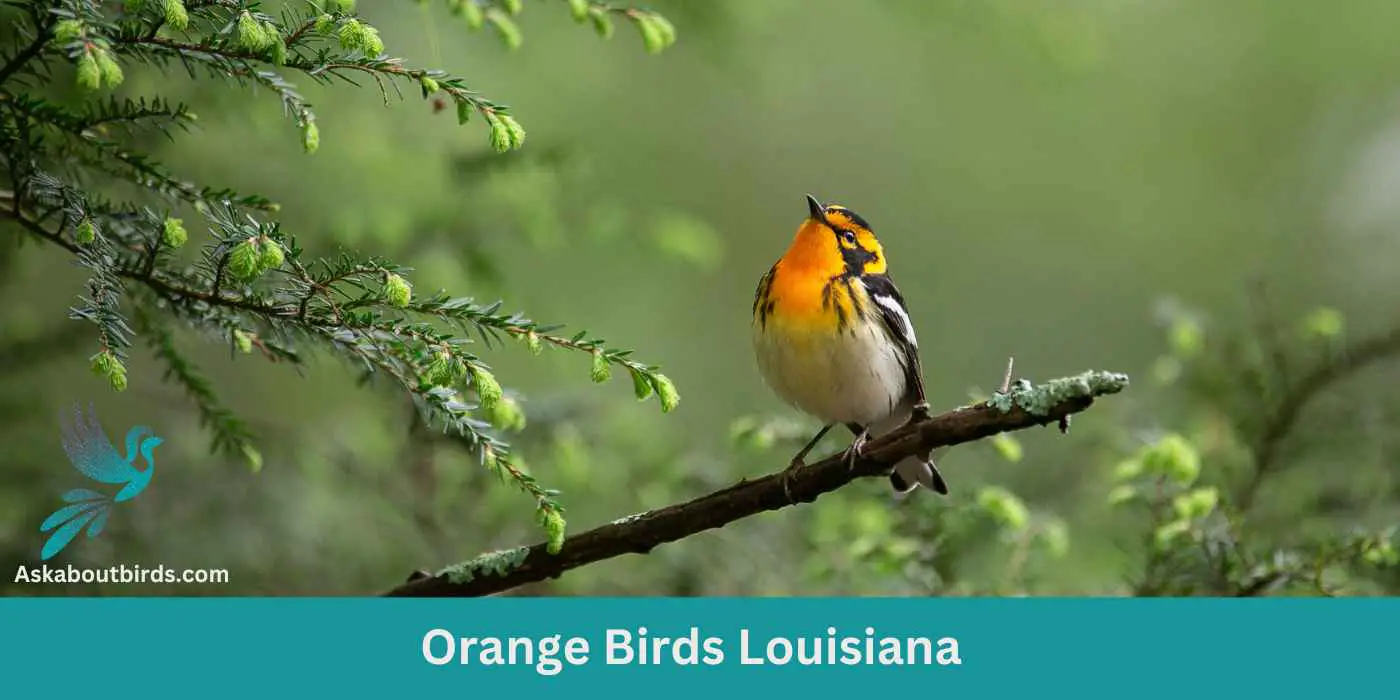From the mysterious bayous to the vibrant wetlands, Louisiana’s diverse habitats are a haven for countless bird species. Drenched in the vibrant hues of the southern sun, Louisiana is not just home to a rich culture and history but also to a spectacular array of avian wonders.
Whether you’re an ornithologist, a birdwatching enthusiast, or someone who simply admires the beauty of nature, this free photo guide is tailored just for you. Among the colorful avian residents of the Pelican State, a special group stands out: the captivating orange birds.
Orange Birds Found In Louisiana
Louisiana, being located in the Mississippi Flyway and having a mix of habitats from coastal marshes to hardwood forests, supports a wide range of bird species. It’s unique blend of bayous, marshlands, and forests creates a haven for a rich diversity of bird species. The presence of these birds can also vary based on the season, migration patterns, and habitat changes.
Orchard Oriole
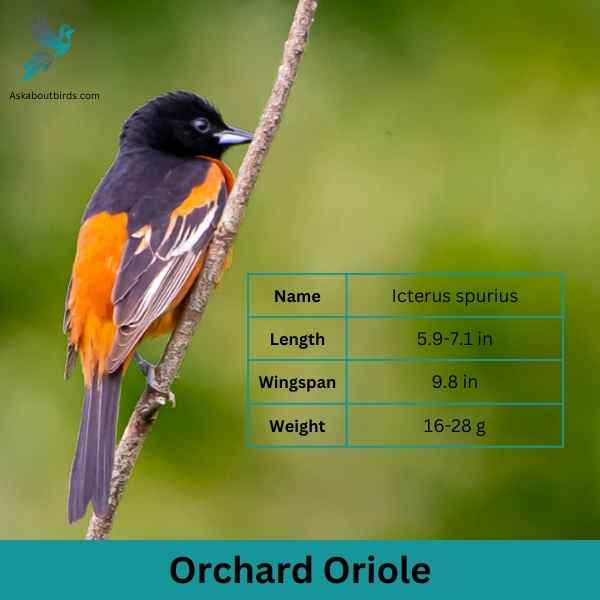
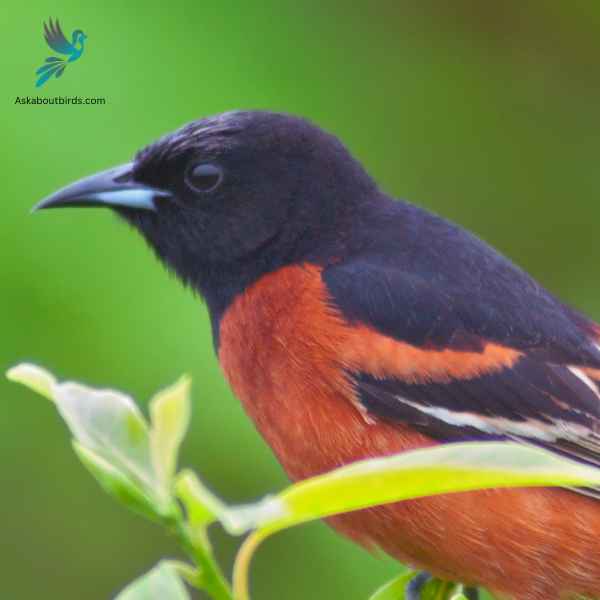
| Feature | Measurement |
|---|---|
| Scientific Name | Icterus spurius |
| Length | 5.9-7.1 in |
| Wingspan | 9.8 in |
| Weight | 16-28 g |
The Orchard Oriole is a small songbird noted for its distinctive coloration and melodic song.
Appearance: Male Orchard Orioles are a striking sight with their dark chestnut body and black head and black and white wings, while females and immature males are olive-green and feature a yellowish underpart. The species is often recognized by its slender body and pointed bill.
Diet: The diet of the Orchard Oriole consists primarily of insects, fruits, and nectar. They are adept at catching insects mid-air and are also known to sip nectar from flowers, aiding in pollination. When fruits are in season, they make up a substantial portion of the bird’s diet.
Reproduction: Orchard Orioles often nest in open woodlands and orchards, hence their name. The female is responsible for building the nest, typically choosing a location in a tree or shrub. The female lays a clutch of 4 to 6 eggs, which she incubates for about two weeks.
Baltimore Oriole


| Feature | Measurement |
|---|---|
| Scientific Name | Icterus galbula |
| Length | 6.7–8.7 in |
| Wingspan | 9.1–12.6 in |
| Weight | 22.3-42 g |
The Baltimore Oriole is a stunning bird, best known for its vibrant coloration and its rich, whistling song.
Appearance: The male Baltimore Oriole is notable for his bright orange and black plumage and black and white wing bars, a stark contrast to the more muted yellow-brown coloration of the female. Both sexes, however, have long pointed bills and white bars on their wings.
Diet: Baltimore Orioles have a diverse diet that includes insects, fruits, and nectar. Their preference for sweet juices and fruit pulp often brings them to backyard feeders offering oranges and jelly.
Reproduction: The female Baltimore Oriole is responsible for building the distinctive hanging nest, often woven together from fine materials like hair and grass. These nests are usually high in trees to avoid predators. The female lays 3-7 eggs, which are incubated for about two weeks.
American Robins


| Feature | Measurement |
|---|---|
| Scientific Name | Leptotila plumbeicep |
| Length | 10.6-11.8 in |
| Wingspan | — |
| Weight | 160-200 g |
The American Robin is a widely recognized bird species known for its melodious song and early bird tendencies.
Appearance: American Robins are medium-sized birds with a distinctive appearance. Both males and females sport a gray to brown back and a warm red to orange breast and belly and gray wings. They also have a characteristic white eye-ring and a black head, but males are usually darker than females.
Diet: American Robins have a diverse diet that changes depending on the season. In summer, they feed heavily on earthworms, beetles, and other invertebrates, which they catch on the ground. During winter, they mostly eat fruits and berries.
Reproduction: American Robins usually build their nests in trees or shrubs, but they are also known to nest on human-made structures. The female lays a clutch of about 3 to 5 eggs, which she incubates for about 12 to 14 days.
Barn Swallow

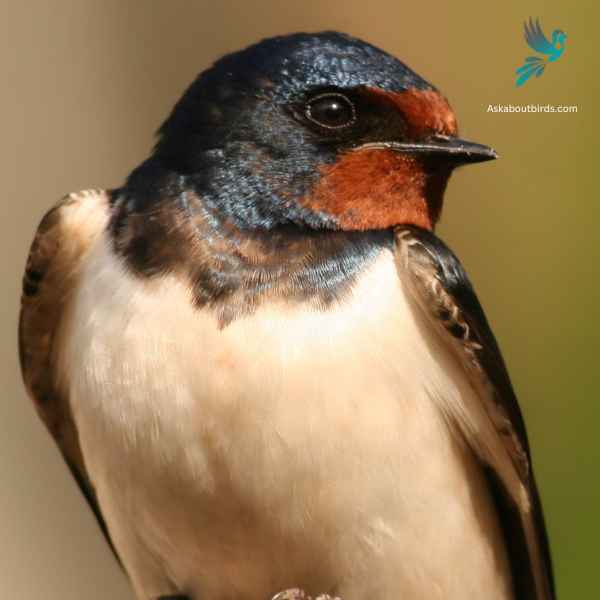
| Feature | Measurement |
|---|---|
| Scientific Name | Hirundo rustica |
| Length | 6.5–7.5 in |
| Wingspan | 12.5–13.5 in |
| Weight | 16–22 g |
The Barn Swallow is a sleek, agile bird renowned for its graceful flight patterns and iconic forked tail, often seen darting over fields and water bodies in search of flying insects.
Appearance: Barn Swallows have deep blue, almost iridescent, upperparts and a rufous to tawny underbelly. Their distinctively forked tail and long wings give them a streamlined look. Both males and females have a similar appearance, though males often exhibit slightly brighter colors and a deeper fork in the tail.
Diet: Barn Swallows feed primarily on flying insects, which they catch in mid-air during their agile and acrobatic flights. Their diet includes flies, beetles, moths, and other small flying insects.
Reproduction: Barn Swallows are known for building their mud nests on man-made structures, particularly barns, bridges, and eaves. The nest is cup-shaped and made from mud pellets, often lined with feathers. The female lays a clutch of 4 to 6 eggs.
Red-breasted Nuthatch

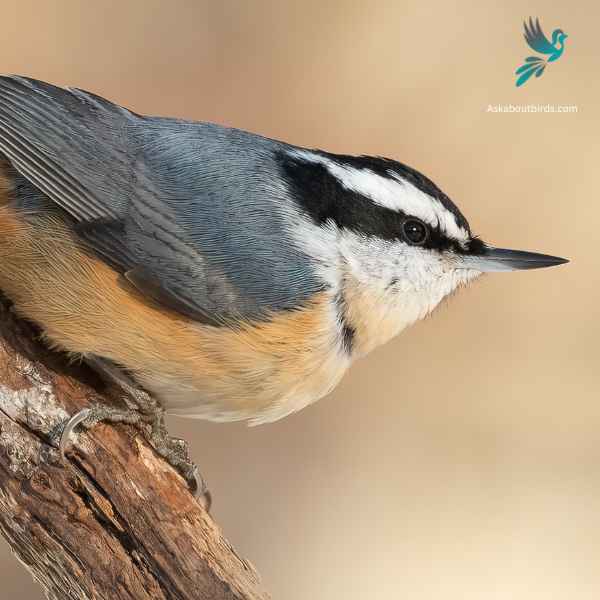
| Feature | Measurement |
|---|---|
| Scientific Name | Sitta canadensis |
| Length | 4.3–4.7 in |
| Wingspan | 8.3 in |
| Weight | 0.3–0.5 oz |
The Red-breasted Nuthatch is a small, agile songbird, known for its ability to move headfirst down tree trunks while searching for food.
Appearance: This bird boasts a slate-blue back and a pale rust-red underside. A prominent black stripe runs through the eye and is bordered above by a white eyebrow. Their sharp, pointed bill is characteristic of the species.
Diet: Red-breasted Nuthatches primarily feed on insects and seeds, especially those from coniferous trees. They have a fondness for large seeds, which they wedge into bark crevices to hack open with their bills.
Reproduction: These birds construct nests in natural tree cavities or abandoned woodpecker holes, often lining the entrance with resin. This is thought to deter predators or competitors from entering. The female typically lays a clutch of 5 to 6 eggs, and both parents partake in feeding the chicks once they hatch.
Eastern Towhee

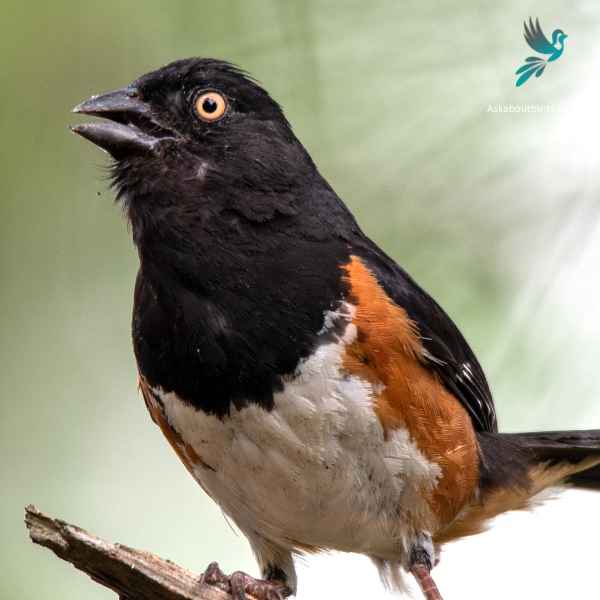
| Feature | Measurement |
|---|---|
| Scientific Name | Pipilo erythrophthalmus |
| Length | 6.8 to 9.1 in |
| Wingspan | 7.9–11.8 in |
| Weight | 32 to 53 g |
The Eastern Towhee is a distinctive songbird known for its unique calls and eye-catching coloration.
Appearance: Male Eastern Towhees are characterized by a striking combination of a black head, back and tail, contrasting with a white belly and rufous flanks. Females sport similar patterns but instead of black, they have a rich brown color. Both genders have red eyes, lending a special charm to their overall appearance.
Diet: Eastern Towhees primarily feed on a variety of insects, seeds, and berries. Their diet is quite diverse, taking advantage of seasonal offerings, which includes beetles, caterpillars, spiders, acorns, grass seeds, and various fruits and berries.
Reproduction: Eastern Towhees build their nests on or near the ground, often in a shrub or a small tree. The female lays around 3-5 eggs and takes the primary role in incubating them over about 12-13 days.
American Redstart


| Feature | Measurement |
|---|---|
| Scientific Name | Setophaga ruticilla |
| Length | 4.3 to 5.5 in |
| Wingspan | 6.3 to 9.1 in |
| Weight | 8.6 g |
The American Redstart is a lively warbler known for its vivid colors and active hunting style, often seen flitting about, fanning its tail to startle and catch insects.
Appearance: Adult male American Redstarts boast striking black plumage with bright orange patches on the sides, wings, and tail. Females and immature males have grayish-olive upperparts with yellow patches in the same areas where the males display orange.
Diet: American Redstarts are primarily insectivores. They actively forage for flying insects, as well as caterpillars and spiders, often using their colorful tails to startle prey and make them easier to catch.
Reproduction: The female American Redstart builds a cup-shaped nest in the fork of a tree branch. Typically, she lays a clutch of 3 to 5 eggs. The female takes on the primary responsibility of incubating the eggs, while both parents participate in feeding the fledglings after they hatch.
Blackburnian Warbler
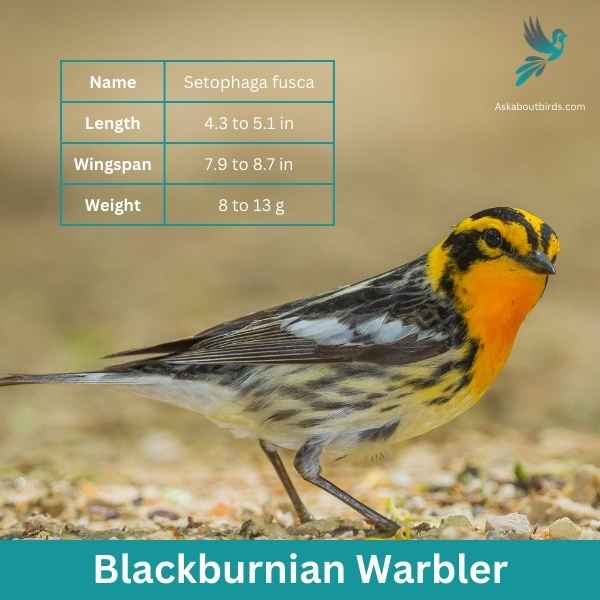

| Feature | Measurement |
|---|---|
| Scientific Name | Setophaga fusca |
| Length | 4.3 to 5.1 in |
| Wingspan | 7.9 to 8.7 in |
| Weight | 8 to 13 g |
The Blackburnian Warbler is a strikingly colored songbird that captivates observers with its vivid plumage, especially during the breeding season. Often found flitting high in the treetops of North American forests, its melodious song is as enchanting as its appearance.
Appearance: Male Blackburnian Warblers are distinguished by their fiery-orange throats, contrasting sharply with a black face, crown, and streaked back. They also have white underparts with black streaks on the sides. Females have a more muted coloration, with a yellowish or pale orange throat and less pronounced streaking.
Diet: Blackburnian Warblers primarily feed on insects and spiders. They are adept at foraging in the canopy, where they glean insects from the surface of leaves and branches or catch them mid-air in quick, agile flights.
Reproduction: Blackburnian Warblers build their nests high up in coniferous trees, often on horizontal branches. The nest is a neat cup made of twigs, grass, and moss, lined with softer materials like hair or feathers. The female lays a clutch of 4 to 5 eggs and takes the lead in incubation.
Where to Spot Louisiana’s Orange Birds
Louisiana, with its rich tapestry of swamps, bayous, and forests, offers an unparalleled birding experience. Here are some of the best spots to witness the state’s ornithological treasures:
- Barataria Preserve (Jean Lafitte National Historical Park and Preserve): Situated just outside New Orleans, this vast wetland habitat is home to over 200 bird species. Its boardwalk trails provide excellent vantage points for birdwatching, especially during migration seasons.
- Cameron Prairie National Wildlife Refuge: Located on the Gulf Coast, this refuge offers freshwater marshes and ponds. It’s a key stopover for migratory birds, and an excellent spot to view waterfowl, waders, and the stunningly orange Prothonotary Warbler.
- Sabine National Wildlife Refuge: As one of the largest coastal marshes refuge, Sabine provides a haven for over 300 species of birds. From shorebirds to songbirds, it’s especially known for its spring and fall migrations.
- Grand Isle: Recognized as a birdwatcher’s paradise, Grand Isle hosts an annual migratory bird festival. The island’s various habitats support a variety of species, making it a top destination for bird enthusiasts.
- Lake Martin (Cypress Island Preserve): Located near Lafayette, Lake Martin is renowned for its rookeries, hosting large numbers of nesting waders. The surrounding cypress-tupelo swamp is home to various songbirds, including several orange-tinted species.
| State’s Orange Birds | Best Spots to See Orange Birds |
|---|---|
| Texas’s Orange Birds | High Island – Especially during spring migration, Laguna Atascosa National Wildlife Refuge – A hotspot for various birds, South Padre Island – Notably for its birding centers. |
| Arkansas’s Orange Birds | Hot Springs National Park – Rich in diverse bird species, Holla Bend National Wildlife Refuge – A haven for migratory birds, Mount Magazine State Park – Elevated location offering diverse birding opportunities. |
| Mississippi’s Orange Birds | Noxubee National Wildlife Refuge – Known for its waterfowl and woodland birds, Dauphin Island – A significant stopover for migrants, Tishomingo State Park – Rugged landscape attracting varied bird species. |
FAQs on Orange Bird Species Found in Louisiana
Which birds with bright orange plumage are commonly seen in Louisiana?
In Louisiana, bird enthusiasts often spot the Eastern Bluebird, known for its bright orange breast and blue-gray wings. These birds frequent bird feeders and are a joy to watch, especially at the forest edges. They mostly feed on insects but also enjoy sunflower seeds from backyard bird feeders.
What yellow birds can one expect to see throughout Louisiana?
The Yellow-Rumped Warbler, with its distinct bright yellow rumps and throats, is a common sight in Louisiana, especially in pine forests. These birds, also known as “Myrtle Warblers” in the eastern half of North America, typically eat seeds. However, they shift their diet to mostly insects during the breeding season. You might also spot them alongside other bird species like the Pine Warbler and the Yellow-throated Vireo.
Which orange-bellied birds should bird watchers look for in Louisiana?
The Orange-crowned Warblers, which breed in the region, are a treat to spot. They have a subtle orange belly, and while their orange crown is often hidden, their greenish-yellow overall coloration and the unique habitat preferences make them distinct. Bird watchers should also note that these warblers are about the size of a typical Barn Swallow and might be seen feeding on flying insects.
Which common backyard birds in Louisiana visit bird feeders?
The American Robin, with its rusty orange breast and dark brown head, is a frequent visitor to bird feeders in Louisiana. These birds, prevalent throughout the eastern United States, are known to eat seeds, especially black oil sunflower seeds left in the bird feeder. In the company of other birds like Eastern Bluebirds and Purple Finches, they are a delight to observe and are among the top backyard birds in the region.
In Louisiana, bird enthusiasts are often treated to the sight of adult male Blackburnian Warblers, which boast bright orange patches on their throats, and American Redstarts, characterized by their two white wing bars contrasting against their black wings. The Blackburnian’s fiery throat contrasts dramatically with the black of its upper parts, making it a sight to behold. Meanwhile, male American Redstarts flash their bright orange patches in the wings and tail, which stand out prominently against their predominantly black plumage. Or the the Common Yellowthroat (Geothlypis trichas). It’s a species of warbler, and the adult males typically have a bright yellow throats and chest, set off by a distinctive black “bandit mask” across their eyes.

